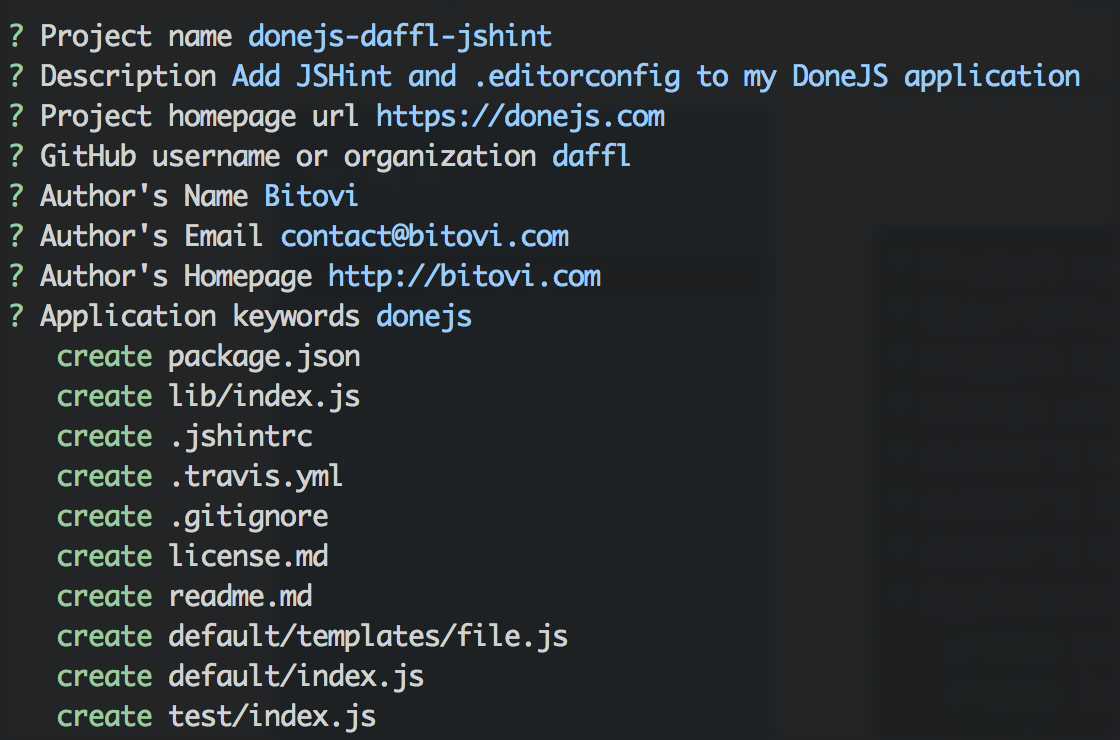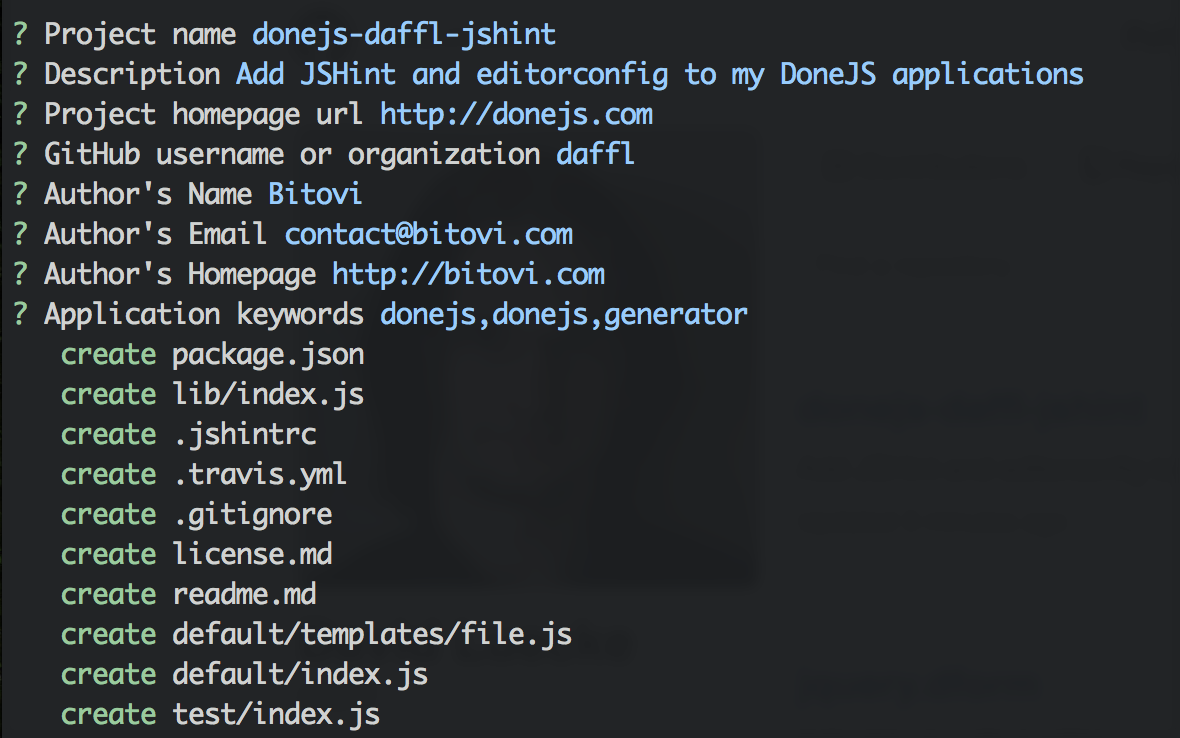The JS ecosystem is vast and we will never be able to support every JavaScript tool out there. However, we do want to make it simple for other open source developers to make those add-ons, and make it easy for others in the DoneJS community to use them. This is where DoneJS's generator generator comes in. It can be used to create modules that add functionality to an existing DoneJS application.
If you have used donejs add nw or donejs add cordova to create a desktop- or mobile version of your application you already used a DoneJS generator. Generators are npm modules that provide a Yeoman generator that adds functionality to your application.
In this article you will create your own version of donejs-jshint, a DoneJS generator that adds JSHint, a JavaScript code quality tool and an .editorconfig file which helps text editors and IDEs to define and maintain a consistent coding style. It will also update the npm test script to run JSHint with our tests.
- Create the project on GitHub
- Initialize the repository as a new DoneJS generator
- Set up continuous integration with Travis CI
- Add .jshintrc and .editorconfig template files
- Implement the generator functionality
- Test the functionality manually
- Write unit tests for the generator
- Publish the plugin to npm
- Show it off to the world
You can find the code in the donejs-jshint repository. A video walkthrough of this article is available here:
We can run the generator with:
$ donejs add jshint
Currently it will only ask if we want to use spaces or tabs and to overwrite the package.json to add the npm scripts for JSHint:

Note: Since
donejs-jshintalready exists we will usedonejs-<username>-jshintwith<username>being your GitHub username for the remainder of this article. Once published it can then be used asdonejs add <username>-jshint.
Setting up
Creating the project on GitHub
We will use GitHub to host the code for the project which makes it easy for others to contribute and to automatically run the tests in continuous integration which we will enable later.
If you don't have an account yet, go to GitHub to sign up and follow the help on how to set it up for the command-line git. Once completed, create a new repository from your dashboard.
Calling the repository donejs-<username>-jshint and initializing it empty (without any of the default files) looks like this:

After creating the repository, clone it into a new folder:
$ git clone git@github.com:<username>/donejs-<username>-jshint.git
$ cd donejs-<username>-jshint
Initializing the project
To initialize a new generator you will need DoneJS version 0.9.0+ installed globally. To check your DoneJS version run
$ donejs --version
To install DoneJS or to get the latest version run:
$ npm install donejs -g
In the donejs-<username>-jshint folder we can now initialize a new generator, very similar to a new DoneJS application, like this:
$ donejs add generator
The generator will ask several question that should be answered as follows:
- For the project name you can just confirm the default by pressing enter
- For the GitHub username or organization enter the GitHub username where the repository has been created
- All other fields can also be answered with the default or the information you would like to use
Once all done, the final prompt looks similar to this:

Now the generator will initialize the default layout and install all its dependencies.
Setting up Travis CI
When the installation has completed, make sure everything got set up properly by running:
$ npm test
This will run some basic generator tests and output the result on the console.
This command can also be used to automatically run the tests on a continuous integration server. There are many open source CI servers, the most popular being Jenkins, and many hosted solutions like Travis CI.
We will use Travis CI as our hosted solution because it is free for open source projects. It works with your GitHub account which it will use to sign up. Once signed in, go to Accounts (in the dropdown under you name) to enable the donejs-<username>-jshint repository:

You may have to click the "Sync account" button for the repository to show up. Now, every time we push to GitHub the tests will run automatically. We can do so with our initial commit:
$ git add . --all
$ git commit -am "Initial commit"
$ git push origin master
If you now go https://travis-ci.org/<your-username>/donejs-<username>-jshint/builds you will see the build running and eventually turn green (which will update the badge that got added in the readme.md file).
Adding the configuration files
Now we can add the files that our generator should produce. All file templates will be put in the default/templates/ folder.
.jshintrc
First, add a default/templates/.jshintrc file which contains options for JSHint:
{
"node": true,
"esnext": true,
"bitwise": true,
"camelcase": true,
"curly": true,
"eqeqeq": true,
"immed": true,
"indent": 2,
"latedef": "nofunc",
"newcap": false,
"noarg": true,
"regexp": true,
"undef": true,
"unused": true,
"strict": false,
"trailing": true,
"smarttabs": true,
"white": false
}
.editorconfig
Next add a default/templates/.editorconfig file like this:
; Unix-style newlines
[*]
end_of_line = LF
indent_style = <%= indent_style %>
trim_trailing_whitespace = true
All files support EJS placeholders. Here, <%= indent_style %> will be used for the user choice of using whitespaces or tabs. Finally, remove defaults/templates/file.js since we won't be using it.
Implementing the generator
For the most part, DoneJS generators are simply Yeoman generators so everything documented for writing your own Yeoman generator also applies here. For the user choice of tabs vs. spaces also refer to the chapter about interacting with the user.
Adding the generator functionality
Our generator needs to ask if we want to use spaces or tabs and then copy the .jshintrc and .editorconfig files over to their final destination. We also want to add an npm run jshint script to the package.json and make sure that JSHint runs during npm test. The complete generator at default/index.js looks like this:
var generator = require('yeoman-generator');
var _ = require('lodash');
module.exports = generator.Base.extend({
initializing: function () {
// Read the original package.json
this.pkg = this.fs.readJSON(
this.destinationPath('package.json'), {}
);
// Maintain a list of all files we want to copy over
this.files = [
'.editorconfig',
'.jshintrc'
];
},
prompting: function () {
var done = this.async();
// Create a prompt setting the `indent_style` property
// to `tab` or `space`
this.prompt([{
type: 'list',
name: 'indent_style',
message: 'What indentation style do you want to use?',
default: 'tab',
choices: [
{
name: 'Tabs',
value: 'tab'
},
{
name: 'Spaces',
value: 'space'
}
]
}], function (answers) {
this.props = answers;
done();
}.bind(this));
},
writing: function () {
var pkg = this.pkg;
// Update `package.json` with the `jshint` command
// and update the `test` script
pkg.scripts = _.extend(pkg.scripts, {
test: 'npm run jshint && ' +
_.get(pkg, 'scripts.test',
'echo "No tests specified"'),
jshint: 'jshint ' +
_.get(pkg, 'system.directories.lib',
'src') +
'/. --config'
});
// Write to `package.json` and format accordingly
// This will prompt you to overwrite
var indent = this.props.index === 'tab' ? '\t' : ' ';
this.fs.writeJSON('package.json', pkg, null, indent);
// Install jshint as a development dependency
this.npmInstall([ 'jshint' ], { saveDev: true});
// Got through every file and copy it
this.files.forEach(function(file) {
this.fs.copyTpl(
this.templatePath(file),
this.destinationPath(file),
this.props
);
}.bind(this));
}
});
That's it. Now we have a fully functional generator and can give it a try in a DoneJS application.
Manual testing
When running donejs add <generatorname> DoneJS will
- Check if
donejs-<generatorname>is installed locally - If not install it from NPM
- Then run the generator at
default/index.js
If we want to test our generator without publishing it to npm first we can link it instead. In the generator folder run:
$ npm link
Then go into your test DoneJS application directory:
$ cd ../place-my-order
$ npm link donejs-<username>-jshint
Now we can run
$ donejs add <username>-jshint
Writing a unit test
Yeoman also comes with some tools for testing generators. The test we initially ran with npm test makes sure that default/templates/file.js gets written. Since we deleted that file, update the test at test/index.js to verify that it wrote the files we want with the content we expect:
var path = require('path');
var helpers = require('yeoman-test');
var assert = require('yeoman-assert');
describe('donejs--jshint', function() {
before(function(done) {
// Run the generator in a temprorary directory
helpers.run(path.join(__dirname, '../default'))
.inTmpDir()
// Mock the user input by setting
// `indent_style` to `tab`
.withPrompts({
'indent_style': 'tab'
}).on('end', done);
});
// Verify that `.jshintrc` got written
// and has some content
it('created .jshintrc', function() {
assert.file(['.jshintrc']);
assert.fileContent('.jshintrc',
/"latedef": "nofunc"/);
});
// Verify that `.editorconfig` got written
// with `indent_style` set to our selection
it('.editorconfig with indent_style', function() {
assert.file(['.editorconfig']);
assert.fileContent('.editorconfig',
/indent_style = tab/);
});
// Make sure that `package.json` got updated
// with the `jshint` npm script
it('update package.json', function() {
assert.jsonFileContent('package.json', {
scripts: {
jshint: 'jshint src/. --config'
}
});
});
});
Now we can see all tests passing when running:
$ npm test
Publishing the plugin
Making a pull request
Although we are working on the generator by ourselves for now, GitHub pull requests are a great way to keep track of our progress and to make sure that all tests are passing. In the plugin folder run:
$ git checkout -b generator-functionality
$ git add . --all
$ git commit -m "Implementing JSHint and editorconfig generator"
$ git push origin generator-functionality
And then create a new pull request by going to https://github.com/<username>/donejs-<username>-jshint which will now show an option like this:

Once you created the pull request, you will see a Some checks haven’t completed yet message that will eventually turn green:

Now you can click the "Merge pull request" button. Then in the console, checkout the master branch and pull down the latest changes with:
$ git checkout master
$ git pull origin master
Publishing to npm
For others to be able to use your generator via donejs add <generatorname> have to pulish it to npm. Create a new account and then log in via
$ npm login
Semantic versioning is a great way to communicate new features and breaking changes. The generated plugin already comes with the release scripts to publish new versions according to the major.minor.patch schema. In our case to publish an initial version 0.1.0 we can run
$ donejs release:minor
Now version 0.1.0 of the generator is available and everybody can use it through
donejs add <username>-jshint
Show it off
Once you published your generator, let the world know about it. Tweet @donejs and post it in the DoneJS forums and the DoneJS chat. Those are also great places to get quick help with any questions.


.png)

